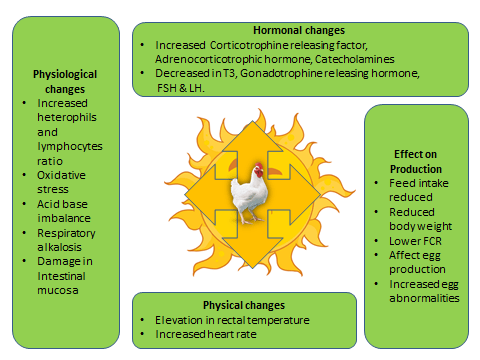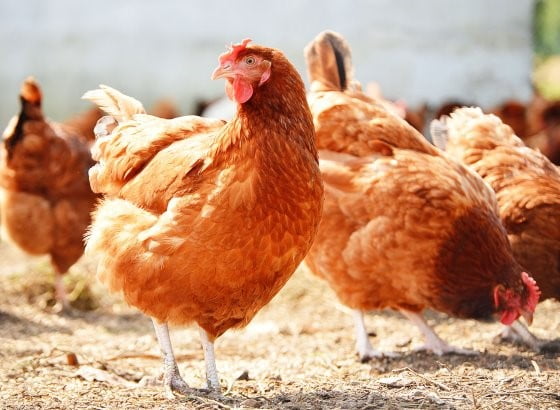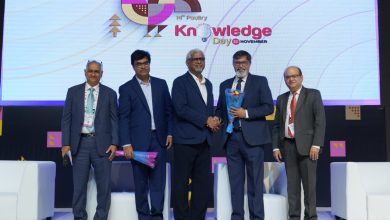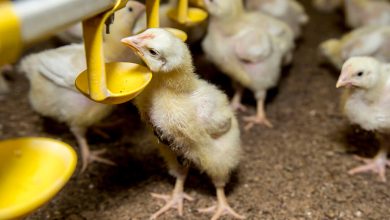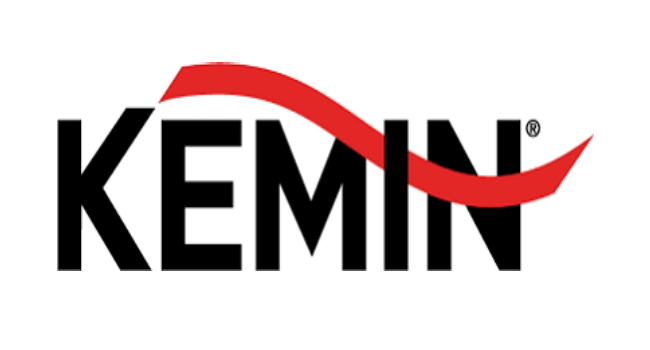HEAT STRESS IN POULTRY: SIGNS, EFFECTS AND MITIGATION STRATEGIES

Dr.R.Selvakkumar. Ph.D., & Dr. G.H.Hudson
Veterinary University Training and Research Centre
Tamil Nadu Veterinary and Animal Sciences University
Nagercoil-629 601
Not only for human, harsh climatic factors put the poultry birds in stress and it affects production and health status of the birds. Stress is a condition in which the birds are exposed to an abnormal environmental factors and it may be climate (Heat or cold), management (Improper ventilation), nutrition (Imbalanced ration), physiological status (Sexual maturity and peak production), physical activities (Rough handling), social (Overcrowding) and psychological (Fear) origin. Among all, climatic stress plays a detrimental role in the productive performance and survivability of poultry birds. Even though the availability of ready reckoner, heat stress in poultry sector is a bottle neck for most of the poultry farmers.
Birds are said to be heat stressed when they have difficulty in achieving balance between body heat loss and body heat production. The normal physiological body temperature of poultry is 41°C (105.8o F) and the birds are experience stress when the environmental temperature goes beyond 35o C.
Key factors triggering heat stress in Poultry
• Intense sun light
• Thermal radiation
• Higher air temperature
• Atmospheric humidity
• Bird’s activity
• Thermoregulatory mechanism of the individual bird
• Housing management
Unlike other stress factors, heat is one of most important environmental factor which affects the poultry bird’s performances including reduced feed intake and this will ends in reduced growth rate, body weight, meat and egg quality, egg production performance and fertility in cocks.
Signs of heat stress in poultry
The following are the signs expressed by the birds exposed to extreme heat. Affected birds may show few or more or all symptoms based on the level of exposure to heat.
• Panting with open mouth breathing
• Elevated wings and lay down on the ground
• Sluggishness in activity
• Closed eyes
• Increased water intake
• Decreased feed intake
• Reduced egg production with reduced egg size, poor shelled egg
• Reduced body weight,
• Cannibalism
Adverse effect of heat stress on poultry
Prolonged exposure of poultry birds to an elevated environmental temperature results in behavioural, physiological and immunological responses, and all together will lead to unfavourable consequences in productivity.
• The early sign expressed by the birds to heat stress is mostly behavioural with an aim of dissipate excess heat produced inside the body. It includes spending less time in standing and walking, increased water intake and decreased feed intake, spread wings, panting and laid on the cooler surface.
• As a physiological response, birds reduced their feed intake in order to avoid excess body heat generation during extreme hot weather. Researchers found that, broilers subjected to chronic heat stress had significantly reduced feed intake, lower body weight, and higher feed conversion ratio at 42 days of age.
• Oxidative changes and acid base imbalance are results of heat stress and this will affect the homeostasis mechanism.
• Exposure of bird to high environmental temperature may affect chemical composition and meat quality in broilers.
• Heat stress has a great influence on reproductive performance and egg quality of birds. In laying hens, the climatic stress will cause decrease egg production and egg quality. Egg production is inversely correlated with environmental temperature.
Approaches to Mitigate Heat Stress in Poultry
Mitigation strategy to overcome heat stress may be from bird’s side or through management or by combination of both.
The birds can be saved themselves to a particular level from heat stress by the thermoregulation mechanism. Thermoregulation is a process by which the birds maintain its core internal temperature to a homeostatic level. This is a state of equilibrium. This can be achieved by one or combination of the following processes.
• Convection ( Body heat lost to cooler surrounding air)
• Conduction (Body heat loss to cooler objects in contact with the bird)
• Radiation (Electromagnetic waves transfer heat through the air to a distant object)
• Evaporative cooling (Heat loss by Rapid, shallow, open-mouth breathing and this will increasing the evaporation of water from the mouth and respiratory tract.
Success of the above said mechanisms is dependent on appropriate environment and proper management activities and this can be achieved by adopting following strategies.
Feeding Strategies
• Restrict feeding is a useful management strategy to overcome the heat stress in poultry. By restricted feeding, the metabolic rate of birds will be reduced and this will stop the further production of heat through metabolism in the stressed birds. But, at the same time, we should take utmost care on nutritive intake of birds and we should achieve the goal by feeding the birds in the cooler part of the day and increase the nutritive density of the feed.
• Wet feed to the heat stressed birds will increase feed intake together with increased water intake. Many studies proved that, wet feeding of poultry birds favours on digestion and absorption.
• Met out the dietary requirement of birds through fat rather than carbohydrate source has been a general practice followed in the heat stressed birds. This will help to increase the energy level with less feed intake and diminish the detrimental effects of heat stress.
Other managemental strategies
• Still air inside the poultry house during high environmental temperature will further stress the affected flock. Flow of air at bird’s level by providing either natural or mechanical ventilation is essential to eliminating the bird’s body heat.
• Metabolic heat produced during hottest period of the day will further aggravate the stress condition. Thus, Feeding the birds during the cooler part of the day will save the birds from the metabolic heat production during peak temperature.
• Water intake by the birds during heat stressed period is normally high (2 to 4 times) and water intake can be encouraged by providing sufficient water space and confirm the availability of cool water throughout the day. Periodical flushing of water line will save the birds from exposure to hot drinking water.
• Exposure of birds in to heat stress will impact the daily requirement and availability of vitamins and minerals due to reduced feed intake and stress response. This will be overcome by supplementing markedly available mineral mixture or electrolytes, phytochemicals and vitamin supplements. (Ex. VENLYTE power, Kem TRACE, CHROMFLEX).
• Physical activities like handling and transport of birds during the hotter part of the day will further worsen the condition of already stressed birds and such kind of activities should be done during cooler part of the day.
• During heat stressed birds consume more amount of water. Therefore, care must be taken while calculate the medication and volume of water while water vaccination.
• Heat-stressed birds having decreased immune function and vaccination in such flocks should be postponed.
Exposure of poultry bird to seasonally high temperature is a great concern, particularly the birds in peak production. Proper housing of birds in a well-ventilated house with an ideal density are key factors to preventing the consequences of heat stress. Strictly adhere with proper feeding schedules and providing nutritive supplements (Vitamins, Minerals and enzymes) will assist in reducing the heat generated by the birds. The altered physiological function of the stressed birds can be resumed by providing bio active compounds which will influence on energy intake, reduce oxidative stress, and metabolic disorders. Antioxidants and phytogenic feed additives are further helpful to reduce the effect of heat stress. In nutshell, well ventilated house, balanced diet to fulfil the nutritive requirement and adopt good management practices are the key factor to overcome heat stress in poultry.
